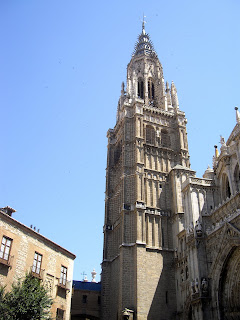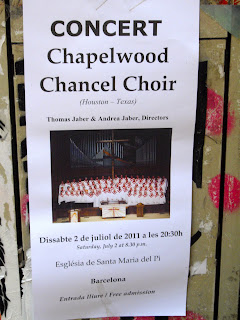
Toledo was Spain's capital city before it was moved to Madrid.
With apologies to the Astros Milo Hamilton, Holy Toledo is pronounced Holy Toe-lay-dough in Spain. The country's first capital city has a proud heritage like so many other cities we visited during our two week journey. The locals admit Seville's cathedral is larger than the one in Toledo, but they believe it is more important. For us it doesn't matter, both are beautiful. We only thought our singing was done last night when we completed our concert in Avila, however we had an impromptu singing of "The Lord's Prayer" inside the cathedral this afternoon. It turned out to be one of the highlights of the tour. The hushed tone inside the exquisitely adorned choir loft brought many to tears. Unfortunately neither photo cameras nor video cameras are allowed to be used inside so the event could not be recorded, but we have the memories.

For a long while Toledo was an icon of religious tolerance. Christians, Muslims and Jews all coexisted with the walls of the city. Of course that all changed as time marched on, but there is a lot to be learned from Toledo's social history. The city was designed to be difficult to negotiate so the streets are narrow and weaved in a labyrinth. The cathedral stands on a hill that is so steep, escalators have been built to help not only tourists but the townspeople up and down the way to the old city. It is still one of the best places in the world to purchase knives as the silver process is so good, it was even mentioned by Shakespeare as his characters often referred to their trusty "toledo" a reference to their sharply edged sword. While today the city is certainly overshadowed by Madrid today, it is a reminder of Spain's past.

As for the concert in Avila last night, it seemed the entire town came out and crammed inside the Auditorio San Francisco. There were many surprises including a solo from Andi Jaber, "His Eye is on the Sparrow," and Janet Coombs helping Peter Johns in the duet part of the opening of "One World." As much as the all the sight seeing was educational, it was the singing which was the most enjoyable. All of the audiences were wonderful, and we leave Spain hoping that we helped enrich, as much as we have been enriched by the tremendous experience.

Our visit to Spain wraps up tonight with a farewell dinner than it's off to bed for a brief nap. We'll be rising at 3:30 a.m., or 8:30 p.m. Houston time to catch our flight to France, and then back to Houston tomorrow afternoon.























